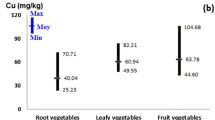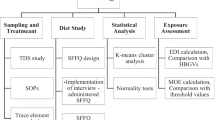Abstract
Soybeans, as legumes, belong among food items that contribute most to the dietary intake of the heavy metal cadmium (Cd). The consumption of soy-based foods may contribute significantly to Cd intake in vegetarians as probably the most frequent consumers of these foods. In this research, the weekly dietary intake of Cd from soy-based foods was investigated in 119 participants (including vegetarians, vegans, and non-vegetarians) in the Czech Republic by means of a semi-quantitative food frequency questionnaire (SFFQ) with personal assistance and the measurement of body weight. Cd content in soy-based foods available on the market was determined by means of atomic absorption spectrometry after microwave digestion. Tofu, as the most frequently consumed food item in the vegetarian/vegan group, contributed most to the total dietary Cd intake. It contained 7.6 ± 0.1 μg Cd/kg, while the highest Cd content was observed in tempeh (18.1 ± 0.4 μg/kg). The highest mean dietary Cd intake per week from soy-based foods was 0.4 μg/kg b.w. and was found in the vegan group. The consumption of soy-based foods was the lowest in the non-vegetarian group as was the dietary intake of Cd, which was 0.04 μg/kg b.w. per week.




Similar content being viewed by others
References
Adams, S. V., Newcomb, P. A., Shafer, M. M., Atkinson, C., Bowles, E. J. A., Newton, K. M., & Lampe, J. W. (2011). Sources of cadmium exposure among healthy premenopausal women. Science of the Total Environment, 409(9), 1632–1637.
American Dietetic Association. (2009). Position of the American Dietetic Association: vegetarian diets. Journal of the American Dietetic Association. https://doi.org/10.1016/j.jada.2009.05.027.
Aoshima, K. (2012). Itai-itai disease: cadmium-induced renal tubular osteomalacia. Nihon Eiseigaku Zasshi. https://doi.org/10.1265/jjh.67.455.
Baba, H., & Tsuneyama, K. (2013). The liver in itai-itai disease (chronic cadmium poisoning): pathological features and metallothionein expression. Modern Pathology, 26, 1228–1234.
European Commission. (2014). Regulation of the European Parliament and of the Council of 12 May 2014 amending Regulation (EC) No 1881/2006 as regards maximum levels of cadmium in foodstuffs, 488/2014/EU. In: Official Journal, L 138/75, 13/5/2014.
European Food Safety Association. (2009). Scientific opinion of the panel on contaminants in the food chain on a request from the European Commission on cadmium in food. The EFSA Journal, 980, 1–139.
European Food Safety Association (2017). Dietary Reference Values for nutrients Summary report. Technical report, https://www.efsa.europa.eu/en/supporting/pub/e15121. Accessed 07 Sept 2019.
Franzaring, J., Fangmeier, A., Schlosser, S., & Hahn, V. (2018). Cadmium concentrations in German soybeans are elevated in conurbations and in regions dominated by mining and the metal industry. Journal of the Science of Food and Agriculture, 99(7), 3711–3715.
Hammad, T. A., Sexton, M., & Langenberg, P. (1996). Relationship between blood lead and dietary iron intake in preschool children: a cross-sectional study. Annals of Epidemiology, 6(1), 30–33.
Huang, M. L., Zhou, S. L., Sun, B., & Zhao, Q. G. (2008). Heavy metals in wheat grain: assessment of potential health risk for inhabitants in Kunshan, China. Science of the Total Environment, 405(1–3), 54–61.
Hunt, J. R. (2003). Bioavailability of iron, zinc, and other trace minerals from vegetarian diets. The American Journal of Clinical Nutrition, 78(3), 633S–639S.
Järup, L. (2002). Cadmium overload and toxicity. Nephrology Dialysis Transplantation, 17(2), 35–39.
Järup, L., & Akesson, A. (2009). Current status of cadmium as an environmental health problem. Toxicology and Applied Pharmacology. https://doi.org/10.1016/j.taap.2009.04.020.
Kellen, E., Zeegers, M. P., Hond, E. D., & Buntinx, F. (2007). Blood cadmium may be associated with bladder carcinogenesis: the Belgian case-control study on bladder cancer. Cancer Detection and Prevention, 31(1), 77–82.
Krajčovičová-Kudládková, M., Ursínyová, M., Masánová, V., Béderová, A., & Valachovicová, M. (2006). Cadmium blood concentrations in relation to nutrition. Central European Journal of Public Health, 14(3), 126–129.
Larson, S. E., & Piscator, M. (1971). Effect of cadmium on skeletal tissue in normal and calcium-deficient rats. Israel Journal of Medical Sciences, 7(3), 495–498.
Leahy, E., Lyons, S. and Tol, R. S. J. (2010) An Estimate of the Number of Vegetarians in the World. ESRI Working Paper. The Economic and Social Research Institute. https://www.esri.ie/pubs/WP340.pdf. Accessed 25 Oct 2019.
Martí-Cid, R., Llobet, J. M., Castell, V., & Domingo, J. L. (2008). Dietary intake of arsenic, cadmium, mercury, and lead by the population of Catalonia, Spain. Biological Trace Element Research, 125(2), 120–132.
Newbigging, A. M., Yan, X., & Le, C. (2015). Cadmium in soybeans and the relevance to human exposure. Journal of Environmental Sciences, 37, 157–162.
Rahimzadeh, M. R., Rahimzadeh, M. R., Kazemi, S., & Moghadamnia, A. (2017). Cadmium toxicity and treatment: an update. Caspian Journal of Internal Medicine, 8(3), 135–145.
Robinson, F., Morritz, W., McGuiness, P., & Hackett, A. F. (1997). A study of the use of a photographic food atlas to estimate served and self-served portion sizes. Journal of Human Nutrition and Dietetics, 10(2), 117–124.
VeganSociety (2019). An affordable, nutritionally balanced and easy to follow meal plan for new vegans (who aren't budding chefs!) [online], https://www.vegansociety.com/resources/lifestyle/shopping/vegan-meal-plan. Accessed 25 Oct 2018.
Vollmann, J., Lošák, T., Pachner, M., Watanabe, D., Musilová, L., & Hlušek, J. (2015). Soybean cadmium concentration: validation of a QTL affecting seed cadmium accumulation for improved food safety. Euphytica, 203, 177–184. https://doi.org/10.1007/s10681-014-1297-8.
WHO (2010). Exposure to cadmium: A major public health concern. World Health Organization, https://www.who.int/ipcs/features/cadmium.pdf?ua=1.Accessed 03 Mar 2018.
Zhuang, P., Li, Z., Zou, B., Xia, H., & Wang, G. (2013). Heavy metal contamination in soil and soybean near the Dabaoshan Mine, South China. Pedosphere. https://doi.org/10.1016/S1002-0160(13)60019-3.
Funding
This work was financially supported by Masaryk University (project MUNI/A/1278/2018) and by funds from the Faculty of Medicine MU to junior researcher Ondřej Zvěřina.
Author information
Authors and Affiliations
Corresponding author
Additional information
Publisher’s note
Springer Nature remains neutral with regard to jurisdictional claims in published maps and institutional affiliations.
Rights and permissions
About this article
Cite this article
Kosečková, P., Zvěřina, O., Pruša, T. et al. Estimation of cadmium load from soybeans and soy-based foods for vegetarians. Environ Monit Assess 192, 89 (2020). https://doi.org/10.1007/s10661-019-8034-7
Received:
Accepted:
Published:
DOI: https://doi.org/10.1007/s10661-019-8034-7




